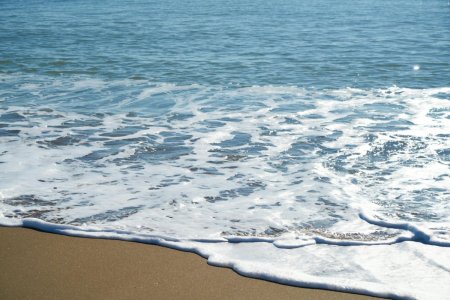Think you can swim safely? National Hurricane Center to roll out new rip current risk map
By
Veronica E.
- Replies 0
There’s nothing quite like a beach day—the sound of the waves, the warmth of the sun, and the joy of being near the water.
But before you head for a swim, there’s something important you should know.
Hidden beneath the surface of those inviting waves, rip currents can form without warning.
They’re not always easy to spot, and even the most experienced swimmers can be caught off guard.
That’s why staying informed could make all the difference for you and your loved ones this summer.

Understanding rip currents: the silent threat
Rip currents are powerful channels of water that move swiftly away from the shore.
They aren’t like crashing waves—they’re narrow, fast-moving rivers of water that can sweep swimmers out to sea in seconds.
These currents typically form when water piled up near the shore by incoming waves finds a narrow path back to deeper ocean water.
The National Hurricane Center's new initiative
With beach season and hurricane season overlapping, the National Hurricane Center (NHC) is launching a new forecast tool to help keep the public safe.
Starting June 1, they’ll begin sharing a rip current forecast map to better inform beachgoers before they even set foot on the sand.
This new map is a timely response to a troubling rise in surf zone deaths, including those caused by rip currents.
The National Weather Service reports an average of 88 surf zone fatalities per year from 2020 to 2023—up significantly from the previous decade’s average of 60.
The rip current risk map will show current and next-day conditions for the East Coast, Gulf Coast, southern California, Puerto Rico, and the US Virgin Islands—making it easier than ever to plan a safe beach visit.
Robbie Berg, a warning coordination meteorologist at the National Hurricane Center, emphasized the importance of the new forecast tool.
"Having this new NWS rip current risk map on hurricanes.gov will help people understand when it might be too dangerous to get in the ocean even if a hurricane is not right on our doorstep," he explained.
The center plans to share rip current risk updates provided by local National Weather Service offices whenever a tropical system is active in the area.
Also read: This grandma's simple advice saved a life—now experts say every family should know it
A community effort for beach safety
In places like Panama City Beach, Florida—where rip current incidents have increased—local leaders and the National Oceanic and Atmospheric Administration (NOAA) are teaming up to improve safety.
From enhanced signage to offshore monitoring sensors, it’s clear that communities are stepping up.
The United States Lifesaving Association supports the added warnings, highlighting that more than 80% of lifeguard rescues at ocean beaches are due to rip currents.
Timely alerts can help families make better decisions and prevent emergencies before they happen.
Also read: Scientists spot terrifying "Black Seadevil" in shallow water—see the rare creature before it vanishes again!
Staying safe: Tips for rip current awareness
Here are a few simple steps you can take to protect yourself and others:
If you’re caught in a rip current
The new rip current forecast is a welcome step forward in keeping the public safe, but each of us has a part to play.
Staying aware and prepared helps ensure that a day at the beach stays just that—relaxing, refreshing, and enjoyable.
Read next: Cruise ship insider reveals secrets: What REALLY goes on in the middle of the ocean!

Have you or someone you know ever experienced a rip current? Do you have helpful beach safety tips to share with others? We'd love to hear your stories in the comments below. Let’s work together to raise awareness and keep each other.
But before you head for a swim, there’s something important you should know.
Hidden beneath the surface of those inviting waves, rip currents can form without warning.
They’re not always easy to spot, and even the most experienced swimmers can be caught off guard.
That’s why staying informed could make all the difference for you and your loved ones this summer.

Staying informed before stepping into the water can make all the difference—check forecasts and posted signs to enjoy a safer beach day. Image Source: Pexels / Engin Akyurt.
Understanding rip currents: the silent threat
Rip currents are powerful channels of water that move swiftly away from the shore.
They aren’t like crashing waves—they’re narrow, fast-moving rivers of water that can sweep swimmers out to sea in seconds.
These currents typically form when water piled up near the shore by incoming waves finds a narrow path back to deeper ocean water.
The National Hurricane Center's new initiative
With beach season and hurricane season overlapping, the National Hurricane Center (NHC) is launching a new forecast tool to help keep the public safe.
Starting June 1, they’ll begin sharing a rip current forecast map to better inform beachgoers before they even set foot on the sand.
This new map is a timely response to a troubling rise in surf zone deaths, including those caused by rip currents.
The National Weather Service reports an average of 88 surf zone fatalities per year from 2020 to 2023—up significantly from the previous decade’s average of 60.
The rip current risk map will show current and next-day conditions for the East Coast, Gulf Coast, southern California, Puerto Rico, and the US Virgin Islands—making it easier than ever to plan a safe beach visit.
Robbie Berg, a warning coordination meteorologist at the National Hurricane Center, emphasized the importance of the new forecast tool.
"Having this new NWS rip current risk map on hurricanes.gov will help people understand when it might be too dangerous to get in the ocean even if a hurricane is not right on our doorstep," he explained.
The center plans to share rip current risk updates provided by local National Weather Service offices whenever a tropical system is active in the area.
Also read: This grandma's simple advice saved a life—now experts say every family should know it
A community effort for beach safety
In places like Panama City Beach, Florida—where rip current incidents have increased—local leaders and the National Oceanic and Atmospheric Administration (NOAA) are teaming up to improve safety.
From enhanced signage to offshore monitoring sensors, it’s clear that communities are stepping up.
The United States Lifesaving Association supports the added warnings, highlighting that more than 80% of lifeguard rescues at ocean beaches are due to rip currents.
Timely alerts can help families make better decisions and prevent emergencies before they happen.
Also read: Scientists spot terrifying "Black Seadevil" in shallow water—see the rare creature before it vanishes again!
Staying safe: Tips for rip current awareness
Here are a few simple steps you can take to protect yourself and others:
- Choose beaches that have lifeguards on duty.
- Check the latest rip current forecasts before heading out.
- Learn the signs: look for breaks in wave patterns, choppy or discolored water, or foam and debris moving out to sea.
- Ask hotel staff or beach rental companies about the safest nearby swimming areas.
If you’re caught in a rip current
- Don’t panic. Rip currents won’t pull you under, but they can carry you away from shore.
- Swim parallel to the shore to escape the current.
- If you can’t break free, float or tread water until help arrives.
- Call for assistance by raising your arms and shouting for help.
The new rip current forecast is a welcome step forward in keeping the public safe, but each of us has a part to play.
Staying aware and prepared helps ensure that a day at the beach stays just that—relaxing, refreshing, and enjoyable.
Read next: Cruise ship insider reveals secrets: What REALLY goes on in the middle of the ocean!
Key Takeaways
- The National Hurricane Center is launching a new rip current risk map to highlight the risks associated with swimming when hurricanes are present.
- The map is designed to be easy for beachgoers to understand and will show risks for the current day, the next day, and the highest risks over both days for several coastal regions.
- Rip currents are fast-flowing streams of water that can surprise swimmers and swiftly carry them away from the beach, contributing to an increase in surf zone fatalities in recent years.
- Beach safety officials and the United States Lifesaving Association welcome the additional warning, as over 80% of rescues at surf beaches are due to rip currents, and early warnings could save lives.
Have you or someone you know ever experienced a rip current? Do you have helpful beach safety tips to share with others? We'd love to hear your stories in the comments below. Let’s work together to raise awareness and keep each other.






